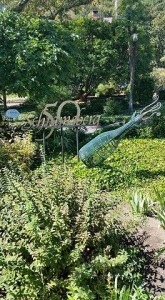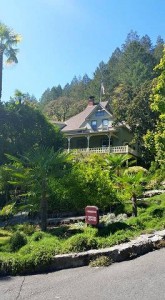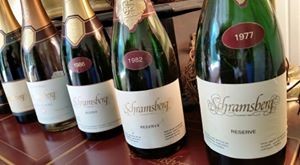Pop! Pop! Pop! For wine fans across the nation, popping corks and sharing bottles of domestic sparkling wines has become a tradition during the holidays. One of the great wineries to thank for this tasty trend is Schramsberg Vineyards in Napa Valley.
 Located on Diamond Mountain near Calistoga, the Schramsberg brand was originally developed by Jacob Schram, who purchased the property in 1862. Following his family’s German tradition of winemaking, Schram established a reputation for making award-winning wines with Riesling, Golden Chesslas, Zinfandel and Petite Sirah grapes grown on the first hillside vineyard in Napa Valley.
Located on Diamond Mountain near Calistoga, the Schramsberg brand was originally developed by Jacob Schram, who purchased the property in 1862. Following his family’s German tradition of winemaking, Schram established a reputation for making award-winning wines with Riesling, Golden Chesslas, Zinfandel and Petite Sirah grapes grown on the first hillside vineyard in Napa Valley.
Following Schram’s death, his son Herman ran the winery until he sold the estate just before Prohibition. Over the next few decades, the property changed hands numerous times before Jack and Jamie Davies purchased it in 1965 with the intent of making sparkling wines that could rival the finest offerings from Champagne.
While renovating the abandon winery, caves, and bringing the Schramsberg brand back to life, the Davies launched their inaugural release, the 1965 Blanc de Blancs, a combination of Chardonnay and a smaller percentage of Pinot Blanc, in 1967. A few vintages later, the name of the brand exploded when President Nixon took bottles of the Blanc de Blancs to the “Toast to Peace” in China in 1972.
Over the first couple decades, most of the fruit for these early wines came from Diamond Mountain, Spring Mountain and the Oak Knoll District in Napa Valley. But that started to shift in the early 1980s, when the family began working with more ultra-premium Chardonnay and Pinot Noir grapes from the cooler climate regions of Carneros, Sonoma Coast, Anderson Valley, and Marin County.
 Fifteen years ago, the focus on making the world-class sparkling wines was passed on to Jack and Jamie’s son Hugh, who was born the same year his parents purchased the property in 1965. Before joining the team, Hugh earned his masters in Enology at University of California Davis and worked harvests at Moet Chandon and Remy Cognac to hone his skills.
Fifteen years ago, the focus on making the world-class sparkling wines was passed on to Jack and Jamie’s son Hugh, who was born the same year his parents purchased the property in 1965. Before joining the team, Hugh earned his masters in Enology at University of California Davis and worked harvests at Moet Chandon and Remy Cognac to hone his skills.
Today, Davies and the winemaking team works with 200 separate lots of fruit picked from 120 different vineyard blocks grown at different elevations and unique soils. Consequently, this diverse mixture of vineyard sources and special sites has resulted in an increase of concentrated flavors, complexity, and natural acidity in all the new Schramsberg releases.
These dynamic flavors shine in the new 2012 Blanc de Blancs (100% Chardonnay, $39), which features elegant notes of spring flowers, brioche, crisp green apple, lemon/lime, grapefruit peel, roasted almond, and spice. Same is true for the 2011 Blanc de Noirs (89% Pinot Noir/11% Chardonnay, $41), which features vibrant flavors of baked red apples, ripe cherry, wild strawberry, raspberry compote, citrus peel, caramel, cinnamon toast, and a long lingering finish.
For the more limited releases wines like the J. Schram, J. Schram Rosé and Schramsberg Reserve, the team has started to ferment the hand-selected lots in a combination of stainless steel and a smaller amount of neutral oak barrels to add more nuances, structure, depth, and rich texture to the finished blend. (Check out the retrospective tasting notes below to see how well these wines age over time).
Other admirable sparklers to look for in the marketplace include:
Schramsberg Brut Rosé, Cremant Demi-sec, Mirabelle Brut and Mirabelle Rosé. Before putting the master blends into individual bottles with dollops of sugar and yeast to start secondary fermentation (the classic methode champenoise process which creates the bubbles); the wines are sterile filtered to insure freshness.
In the bottle, these sparkling gems are aged in the expansive estate caves which were hand-dug by Chinese laborers in the 1880s. According to Hugh, patience is the key. “You can’t make apple pie if you start with apple sauce. Instead, you must let the tart flavors develop over time.”
Beyond bubbles, the winery began making the J. Davies Estate Cabernet Sauvignon in 2001 and more recently launched a special series of limited production Pinot Noirs made with fruit from Anderson Valley and higher elevation vineyards on the Sonoma Coast.
“My parents set us on a track to move forward with our own vision and access to the best possible fruit by developing deep relationships with some of the finest growers on the West Coast,” says Hugh, who lives on the estate with his wife Monique and their three son Emrys, Nelson and Hugh.
“For that reason, we are not afraid to try new things with the intent of making world-class sparklers and still wines that offer complex flavors, subtle nuances, texture and other unique characteristics that are engaging and satisfying from the minute the cork is popped or how well the wines age in the bottle over time.”
Schramsberg Vineyards is open by appointment. For more information, visit www.schramsberg.com. Also, look for Hugh Davies and Schramsberg Vineyards at the upcoming Flavor Napa Valley events, March 16-20.www.flavornapavalley.com.
This fall, to celebrate the 50-year anniversary of Schramsberg Vineyards, Schramsberg President & CEO Hugh Davies and Winemaker Sean Thompson hosted the Golden Bouchon, a special series of exclusive Sparkling Wine Library Tastings at the historic mansion built by Jacob Schram in 1875 at the Schramsberg Estate. Here are my notes from the special sparkling wines and still wines we tasted at this memorable event. -CS
Wine Library Tasting
The Schramsberg Reserve wines are typically made with 70 separate vineyard lots. A percentage of the blend is aged in barrels to create more complex flavors and aromas. It’s also worth noting that there were no reserves from 1987-1993, an important period when the Davies family developed relationships with growers who specialize in Pinot Noir and Chardonnay plantings in the cooler coastal regions of Carneros, Anderson Valley, Sonoma Coast, and Mendocino and Marin Counties. Today, the average retail price of the Schramsberg Reserve is $120; whereas the library selections are priceless.
Schramsberg 2007 Reserve: Lovely aromas and flavors of poached pear, wild strawberry, lemon curd, roasted almonds, truffle, ginger spice, and a long, vibrant finish. Content: 76% Pinot Noir, 24% Chardonnay.
Vineyards: Saltonstall (Sonoma Coast/Petaluma Gap), Stevens (Marin), Juster (Anderson Valley).
Schramsberg 2004 Reserve: Very impressive sparkler with lively flavors of ripe tree fruits, baked apple, wild berries, almond paste, mint, and graham cracker crust. Content: 84% Pinot Noir, 16% Chardonnay.
Vineyards: Corby, Juster (Anderson Valley), Saltonstall (Sonoma Coast/Petaluma Gap), Hyde (Napa Carneros) Stevens (Marin).
Schramsberg 1999 Reserve: Stately sparkling wine that is still so lively and vibrant. Notes of peach, pear, white cherry, fresh ginger, cinnamon toast, creamy texture, and lingering finish. Ripe, zesty, and elegant.
Content: 73% Pinot Noir, 27% Chardonnay. Vineyards: Corby, Husch, Rose, Vidmar (Anderson Valley), Lund (Napa Carneros).
Schramsberg 1994 Reserve: Rich and complex, with flavors of poached pear, peach, citrus, and nutmeg. Graceful and ethereal. Content: 73% Pinot Noir, 27% Chardonnay. Vineyards: Trefethen, Schramsberg (Napa); Cordoniu (Napa Carneros); Ricci (Sonoma Carneros).
Schramsberg 1986 Reserve: Rich, lively and precise. Aromas and flavors of peach, apple, toffee and smoke. Content: 78% Pinot Noir, 22% Chardonnay. Vineyards: 100% from the Schramsberg Estate on Diamond Mountain (Napa).
Schramsberg 1977 Reserve: Sweet core fruit, layered with accents of coconut, vanilla and white chocolate, apple, truffle, caramel, and earth. Content: 78% Pinot Noir, 22% Chardonnay. Vineyards: 100% from the Schramsberg Estate on Diamond Mountain (Napa).
Wine Library Tasting
Made with selective grapes from coastal vineyards, the emphasis of the J. Schrams master blend is Chardonnay with smaller amounts of Pinot Noir. 60-65% is aged in stainless steel barrels; while the other 35-40% is aged in neutral French oak barrels. It’s also interesting to see how the percentage grapes from Sonoma and Marin counties increased 15 years ago. This forward thinking really shows in the 2001, 2003 and 2007 vintages. Retail price of the 2007 J. Schram is $120.
Schramsberg 2007 J. Schram: Lovely floral aromas with hints of fresh citrus, ginger and brioche. Complex flavors of ripe peach, cherry, ripe pineapple, lemon custard, roasted hazelnut; and plenty of backbone for aging in the bottle. Content: 86% Chardonnay. Vineyards, 14% Pinot Noir.
Vineyards: Hyde, Jones, Tognetti, Schwarze (Napa Carneros); Horseshow Bend, Keefer (Sonoma Coast); Stevens (Marin). 12.8% alc.
Schramsberg 2003 J. Schram: Lofty aromas of ripe tree fruits, anise and butterscotch. lead to distinctive flavors of pear, apple, peach, dried honey, mineral and peanut brittle. Lively, vibrant, and inviting.
Content: 85% Chardonnay, 15% Pinot Noir. Vineyards: Hyde, Jones, Tognetti, (Napa Carneros); Sangiacomo Vella, Ricci (Sonoma Carneros); Stevens (Marin). 12.5% alc.
Schramsberg 2001 J. Schram: Soft, luxurious, and sophisticated, this sparkling gem is highlighted with notes of ripe Golden Delicious apple, pineapple, fresh lime, Meyer lemon, exotic melon, white pepper, and creamy texture. Content: 77% Chardonnay, 23% Pinot Noir. Vineyards:
Jones, Tognetti (Napa Carneros); Sangiacomo Vella (Sonoma Carneros); Stevens (Marin). 12.6% alc.
Schramsberg 1999 J. Schram: Due to the long, steady ripening period, the wine spent more time in bottle before being released, so it falls into the Late Disgorged category. The end result is a very complex wine with lovely aromas of spring flowers, white fruits, orange marmalade and fennel; captivating flavors of white peach, apple, lemon zest, ginger; and a long, dry finish. Content: 74% Chardonnay, 26% Pinot Noir.
Vineyards: Tognetti, Schwarze, Hyde, Jones (Napa Carneros); Sangiacomo Donnell (Sonoma Carneros). 12.6% alc.
Schramsberg 1993 J. Schram: Intriguing wine with notes of poached pear, wild mushroom, honey, forest floor, earth, and rustic spices. A great wine to pair with creamy cheeses or mushroom bisque. Content: 82% Chardonnay, 18% Pinot Noir. Vineyards: Hill (Napa Carneros); Schramsberg, Trefethen, Elliot (Napa). 12.5% alc.
Schramsberg 1987 J. Schram: Made with 100% fruit from Napa Valley, this was the first vintage of J. Schram. Today, the wine features notes of apple, pear, almond paste, egg flower soup, and creamy texture. Content:
85% Chardonnay, 13% Pinot Noir, 2% Pinot Noir. Vineyards: Schramsberg, Trefethen, Elliot, Yountville (Napa). 12.9% alc.



